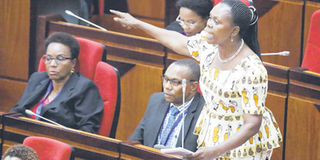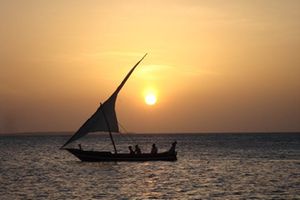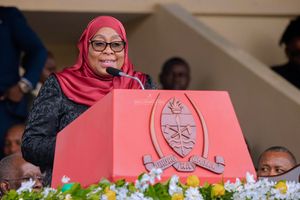No gender equity yet in top leadership

Mlimba MP Susan Kiwanga during a parliamentary session.Although Tanzania has endorsed the 50-50 gender resolution,this ratio is far from being realised. PHOTO|FILE
What you need to know:
- The resolution by the UN has set a goal to reach the 50-50 ratio gender equality between women and men by the 2030.
- Out of the seven districts, five are led by men as District Commissioners whereas the remaining two, Gairo and Morogoro are under female leadership by Siriel Mchemba and Regina Chonjo respectively.
Morogoro. Tanzania’s support for the international resolution on gender equality with specific regard to leadership positions is well documented; however, its implementation in Morogoro Region is still not many a woman’s dream.
The resolution by the UN has set a goal to reach the 50-50 ratio gender equality between women and men by the 2030.
Out of the seven districts, five are led by men as District Commissioners whereas the remaining two, Gairo and Morogoro are under female leadership by Siriel Mchemba and Regina Chonjo respectively.
The statistics put the number of the women DCs at a negligible 28 per cent of the total number of all the DCs in the region.
The gender imbalance in the region extends to other positions such as the council directors. Out of the nine positions, eight are held by men with Gairo as the only exception where Agnes Mkandya is the director.
The position of district administrative secretary is also a male dominated area with only Morogoro Rural where Ms Ruth John is an exception.
This, according to some observers is a step backwards considering the strides that were made in the Fourth Phase administration under President Jakaya Kikwete.
By the time he left office in 2015 Morogoro had two women district council directors, Azimina Mbilinyi of Kilombero and Isabela Chilumba in Ulanga equivalent to 29 per cent.
The region had attained a 50-50 ratio in the DC positions, with three out of the six commissioners being women.
Women DCs were in the districts of Mvomero, Ulanga and Gairo while Morogoro, Kilombero and Kilosa were led by men.
Of the districts that were lucky to taste female leadership, Mvomero has had three female DCs who included Hawa Ng’umbi, Fatuma Mwasa and Betty Mkwasa.
The other women DCs were Halima Dendegu who was in Kilosa before becoming the Mtwara Regional Commissioner, Hanifa Karamagi and Christina Mndeme who was in Ulanga before she was appointed Dodoma DC.
Parliamentary positions
The poor ratio between women and men in leadership positions is not only with the Presidential appointees, but also in elective positions .
Out of 11 constituencies in Morogoro, only Mlimba in Kilombero is led by a woman MP Susan Kiwanga (Chadema).
Even with the addition of two women representatives Dr Christine Ishengoma (CCM) and Devotha Minja (Chadema), still the number of women stands at a dismal 23 per cent.
At grassroots, too, women have not been spared as even there the positions are still dominated by their male counterparts.
An analysis conducted by this paper on councillor positions within Morogoro Municipality shows that out of 29 wards in the municipality, only four are led by women.
Out of the 10 councillors in the Morogoro District Council, nine come from CCM with Chadema taking the remaining seat showing growing women representation by over one third.
Gairo District Council Director Agnes Mkandya says she believes in herself and that the position that she holds has made her stronger than before.
“The council is performing better than before; earnings have increased by several folds under my leadership. I work well with my executives from the grassroots,” says Mkandya.
Gairo District Commissioner Siriel Nchemba says when women work hard they can reach greater heights even with all the odds against them.
Her office has been at the forefront in educating women on how to form entrepreneurial groups and issues of marketing and production.
Public service
The past and present administrations have been making efforts to involve women in various sectors including forming policies and planning the country’s development.
Several women have hold sensitive positions including Parliament, Cabinet, Local Government, boards of corporations and public institutions, political parties and various trade unions and electoral commissions.
However, statistics from the Ministry of State in the President’s (Management and Good Governance) Office indicate that upto last year the number of women leaders in public service from ministerial to councillorship positions stood at some 28 per cent.
Some women were keen on being offered leadership positions in the fifth phase government so that they can be part of the country’s decision making machinery.
Their call to President John Magufuli was to increase the number of women holding leadership positions in the government.
Angela Leonard says many women appointed to hold leadership positions have done well in the past with a track record that is quite impeccable especially when it comes to honesty.
“In Morogoro Region this time around there are very few women leaders, both appointed and elected. Personally, I see the male chauvinism reigning more than the past administrations. I don’t know how the other regions are faring,” says Angela Leonard.
The journey towards 50-50
The Parliament has been advocating for more women to be at the level of decision making, a struggle that started over 30 years ago.
In the 1980s, Bunge made the decision to allocate 10 per cent of Parliamentary seats to women.
That number has been steadily increasing from one phase to another because of Special Seats, which have been constitutionally created.
By December last year, there were 141 women MPs out of 380, taking the ratio to 37-63
The Director of the Tanzania Media Women’s Association (Tamwa), Edda Sanga, told The Citizen that the issue of gender equality, depended on the one with the mandate of making decisions.
“These things largely depend upon one era after another. We cannot compare between the past and the present because there have been great changes now and it is possible that our president has strategies of his own about this matter. So, let’s wait and see,” says Ms Sanga.
At a time when women activist seem to be silent, Ms Sanga says this shouldn’t be mistaken for being dormant because they are busy watching what the government is doing.
“There is constant follow-up on the stand of the head of state,” she says. Morogoro Paralegal Centre (MPLC) director Flora Masoy believes it is more of a mindset issue which she says has to change if at all women are to register further success at various levels.
Masoy says there is still need to raise voices concerning the necessity to have more women in leadership positions.
However, she says the beginning is always difficult and that the issue of gender equality may change in the coming days
“I don’t think if the president has any ill intention. Let’s keep waiting things could be fine. I know it will take time to make this happen,” says Masoy.




